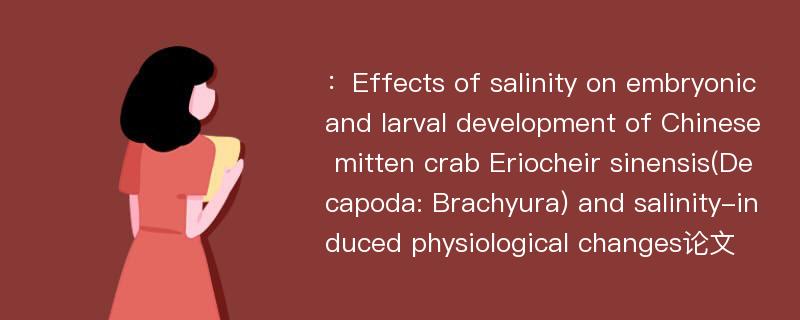
本文主要研究内容
作者(2019)在《Effects of salinity on embryonic and larval development of Chinese mitten crab Eriocheir sinensis(Decapoda: Brachyura) and salinity-induced physiological changes》一文中研究指出:To investigate the effects of salinity on early development of Chinese mitten crab(Eriocheir sinensis),and the salinity tolerance mechanism of embryos,different developmental stages of embryos(gastrula,eyespot and pre-hatching stage),and hatched stage I zoea and megalopa,were exposed to a range of salinities(1,5,10,15(control),20,25,30,35 and 40).Hatching,survival and molting were monitored.Effects of 24-hour hypersaline(35)and hyposaline(1)stress on egg diameter,water content,Na~+/K~+-ATPase(NKA)activity,and crustacean hyperglycemic hormone(CHH)gene mRNA expression in embryos and megalopa,are reported.Embryos are more tolerant of low(≤5)than high(≥25)salinities,with optimum ranges for gastrula and pre-hatching stage embryos being 5-20,and for eyespot embryo and stage I zoea,10-20.Most megalopa can molt to the first juvenile instar by day 5 at salinities between 1 and 40,whereas molting of megalopa stages was delayed at 40.Hypersaline conditions resulted in a loss of moisture,reduction of egg volume,and a significant increase in NKA activity and CHH mRNA expression at some developmental stages.Hyposaline conditions did not affect moisture content or egg volume,but resulted in decreased NKA activity and CHH mRNA expression in embryos.For megalopa stages,NKA activity was significantly upregulated following both hypo-and hypersaline stress.Our results suggest high salinity will inhibit development and hatching of E.sinensis embryos,and low salinity will affect the survival of their stage I zoea.Increased NKA activity in embryos and megalopa stages might indicate a hyporegulation response under hypersaline conditions.These findings provide useful information for spawning ground protection of indigenous E.sinensis and enrich the knowledge of embryonic tolerance mechanisms of hyperregulating crustaceans following osmotic stress.
Abstract
To investigate the effects of salinity on early development of Chinese mitten crab(Eriocheir sinensis),and the salinity tolerance mechanism of embryos,different developmental stages of embryos(gastrula,eyespot and pre-hatching stage),and hatched stage I zoea and megalopa,were exposed to a range of salinities(1,5,10,15(control),20,25,30,35 and 40).Hatching,survival and molting were monitored.Effects of 24-hour hypersaline(35)and hyposaline(1)stress on egg diameter,water content,Na~+/K~+-ATPase(NKA)activity,and crustacean hyperglycemic hormone(CHH)gene mRNA expression in embryos and megalopa,are reported.Embryos are more tolerant of low(≤5)than high(≥25)salinities,with optimum ranges for gastrula and pre-hatching stage embryos being 5-20,and for eyespot embryo and stage I zoea,10-20.Most megalopa can molt to the first juvenile instar by day 5 at salinities between 1 and 40,whereas molting of megalopa stages was delayed at 40.Hypersaline conditions resulted in a loss of moisture,reduction of egg volume,and a significant increase in NKA activity and CHH mRNA expression at some developmental stages.Hyposaline conditions did not affect moisture content or egg volume,but resulted in decreased NKA activity and CHH mRNA expression in embryos.For megalopa stages,NKA activity was significantly upregulated following both hypo-and hypersaline stress.Our results suggest high salinity will inhibit development and hatching of E.sinensis embryos,and low salinity will affect the survival of their stage I zoea.Increased NKA activity in embryos and megalopa stages might indicate a hyporegulation response under hypersaline conditions.These findings provide useful information for spawning ground protection of indigenous E.sinensis and enrich the knowledge of embryonic tolerance mechanisms of hyperregulating crustaceans following osmotic stress.
论文参考文献
论文详细介绍
论文作者分别是来自Journal of Oceanology and Limnology的,发表于刊物Journal of Oceanology and Limnology2019年05期论文,是一篇关于,Journal of Oceanology and Limnology2019年05期论文的文章。本文可供学术参考使用,各位学者可以免费参考阅读下载,文章观点不代表本站观点,资料来自Journal of Oceanology and Limnology2019年05期论文网站,若本站收录的文献无意侵犯了您的著作版权,请联系我们删除。
